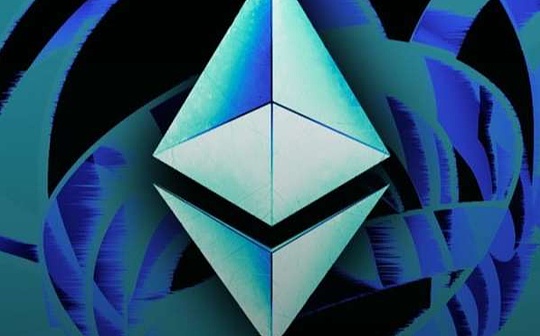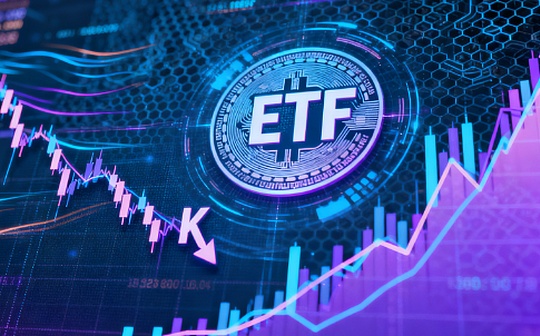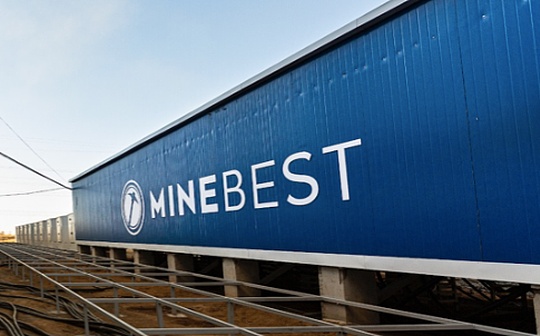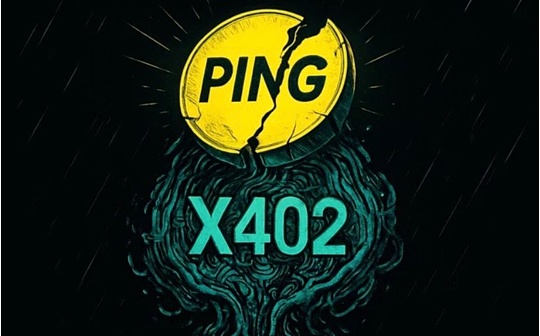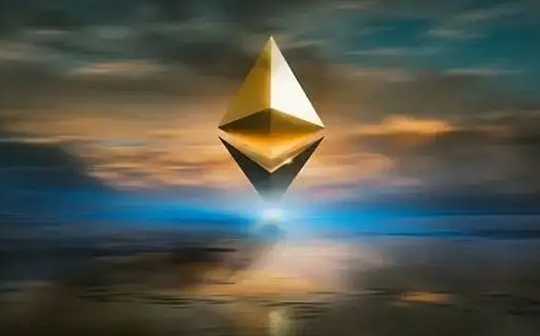
Author: LINDABELL
At a recent Devcon conference, Justin Drake, a core member of the Ethereum Foundation, proposed the Beam Chain proposal, planning to upgrade the Ethereum consensus layer through zkSNARK and zkVM technologies to improve the scalability, security and efficiency of the network.This vision also brought the importance of zkVM to attention again.As a general zero-knowledge virtual machine, zkVM can handle complex computing in a more flexible and efficient way, while getting rid of the dependence on traditional smart contract logic.
Driven by this trend, projects such as RISC Zero, Succinct and Cysic are seen as important players in driving innovation in this field.Among them, RISC Zero has developed a series of open source tools such as Zeth, Kailua and Bonsai with zkVM based on RISC-V architecture, which not only improves the performance of block verification and Rollup, but also provides technical support for Ethereum ZK upgrades.
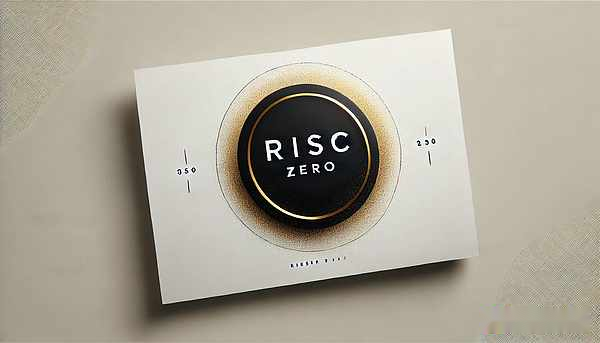
RISC zkVM Ecological Product Matrix: From Core Technology to Scenario Application
RISC Zero is a zkVM implementation based on the RISC-V instruction set architecture. As a general zero-knowledge computing platform, it supports a variety of mainstream programming languages, such as Rust and C++, and can run almost any computing task.Compared with other zero-knowledge technology platforms, RISC Zero’s provers and validators are completely open source, and developers can generate and verify proofs locally.In addition, RISC Zero’s validator is compatible with multiple platforms and can adapt to different blockchain ecosystems, simplifying the development process of decentralized applications.
In June this year, RISC Zero released zkVM 1.0.zkVM 1.0 not only supports multiple languages and complex computing tasks, but also uses Continuations technology to segment large-scale computing into multiple small segments to achieve efficient parallel computing and verification.According to the roadmap, RISC Zero plans to achieve 20x improvements in zkVM performance and cost by the end of 2024, with optimizations including full migration of the proof process to the GPU (80% completed), introduction of new RISC-V v2 circuit designs, and targeting recursionSpecial optimization of circuits, etc.At the same time, RISC Zero is integrating a series of acceleration modules for algorithms such as RSA, Keccak, ECDSA, etc. to improve the performance of Ethereum-related tasks and encryption operations.
Focusing on the core capabilities of zkVM, RISC Zero has also developed a series of open source tools and products.For example, through the Bonsai network, the proof service can be generated by developers without dedicated hardware; through the Steel tool, complex EVM calculations can be transferred to off-chain environments to run while maintaining the results verifiable, reducing on-chain execution costs;Blobstream Zero provides more possibilities for data sharing and verification in the modular blockchain ecosystem by bridging the Celestia data availability layer.
Zeth: Prove that the entire Ethereum block is correctly constructed
Zeth is an open source Ethereum zero-knowledge block proofer developed by RISC Zero based on its zkVM technology. It can verify the validity of Ethereum blocks through zero-knowledge proof without relying on traditional validators or synchronization committees.RISC Zero defines Zeth as Type-0 zkEVM, which is not only fully compatible with the Ethereum protocol, but also improves development efficiency through reuse of code.
In the article “Different types of zk-EVMs”, Vitalik Buterin, co-founder of Ethereum, divides zkEVM into four categories, among which Type-1 strives to be completely and uncompromisingly equivalent to Ethereum; Type-2 strives to be completely equivalent toEVM, but is not completely equivalent to Ethereum; Type-3 is almost equal to EVM; Type-4 is completely incompatible with Ethereum.

Thanks to the high performance of RISC Zero zkVM, Zeth is able to verify the Ethereum block in just minutes.Test data shows that Zeth can generate block proofs at 1.1 MHz and extend the GPU cluster with the “continuations” feature to increase the speed to 4.7 MHz to 6.3 MHz.This performance optimization also reduces the cost of proof generation.According to the test, a block with 182 transactions had a proven generation cost of only $21.72, with a cost of about $0.11 per transaction.
At the same time, during the development of Zeth, the RISC Zero team made full use of components of the Rust ecosystem, such as revm, ethers and alloy, allowing developers to quickly implement block proof functions and apply them to different scenarios.This design provides developers with more flexibility to adjust the block building logic as needed and adapt to future Ethereum improvement proposals.
At the application level, Zeth provides efficient solutions for zk Rollup, light client and cross-chain bridges.The construction of traditional zk Rollup and zkEVM takes a lot of time and money, which discourages small teams.Zeth is based on a modular zkVM architecture, allowing developers to easily customize block verification logic.For example:
-
zk Rollup: Zeth can quickly implement block proof, shorten the development cycle of ZK Rollup and reduce capital investment.
-
Light client: Verify block validity without rebuilding blocks and reduce operating costs.
-
Cross-chain bridge: Zeth can verify the correctness of cross-chain data without leaking sensitive information on the chain, which reduces trust dependence on third parties and reduces the risk of cross-chain attacks.
In May this year, Zeth successfully expanded to support the extraction of Optimism block data from the Ethereum mainnet and generate ZKP to verify the correctness of blocks, and also supports on-chain verification.That is to say, with the help of Zeth, Optimism can more efficiently verify transactions and resolve transaction disputes.
Bonsai: Allows developers to generate proofs without using their own hardware
Bonsai is a remote proof service designed for zkVM applications, allowing developers to generate proofs without using their own hardware, thus solving the contradiction between limited computing resources on-chain and high costs.Through Bonsai, developers only need to define the zkVM application that needs to be executed and input data. Bonsai can run the calculations in the background and generate corresponding zero-knowledge proofs.This process completely eliminates the need for developers to deploy additional hardware devices.At the same time, Bonsai utilizes a large number of GPU clusters to support parallel processing of multiple computing tasks.In addition, Bonsai provides a simple and easy-to-use API and SDK interface, allowing developers to easily integrate it into existing systems, further reducing development difficulties.
Based on this remote proof service, RISC Zero has launched the open source tool Bonsai Pay, which combines OAuth2.0 identity authentication and ZKP technology, enabling users to send or receive tokens on the Ethereum network through their Google accounts.For example, when Alice wants to transfer funds to Bob, Alice can enter Bob’s Google email and transfer amount through Bonsai Pay.Bob can then log in to Bonsai Pay and enter your email address and complete Google Account authentication.Bonsai Pay will use OAuth 2.0 to generate authorized tokens, proving that Bob is indeed the holder of the mailbox.Bonsai Pay then calls the Bonsai proof service to generate a zero-knowledge proof that Bob’s Google account is associated with the wallet address.After the smart contract is verified, the funds are unlocked and transferred to Bob’s wallet address.
During the whole process, Bonsai Pay verified the fact that “Bob’s Google Account is associated with his wallet address” through ZKP technology, and avoided the disclosure of specific information about any Google Account.
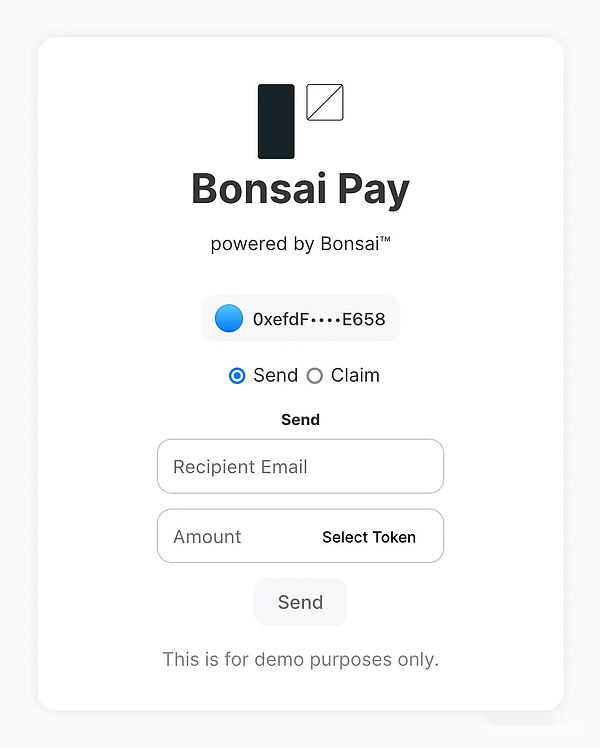
Another important application of Bonsai is the Bonsai ZK coprocessor (ZK Co-processor).It uses zero-knowledge proof technology to transfer complex computing tasks from the chain to off-chain and generates tamper-free proofs to ensure the correctness of the results.At the same time, the deployment of the Bonsai coprocessor is also very simple. The developer only needs to write a zkVM application to process the logic, and call Bonsai through a simple Solidity contract to run the calculation and verify the results.Throughout the process, the Bonsai proof service is responsible for generating zero-knowledge proofs for off-chain computing, which can be verified on-chain.
The Bonsai ZK coprocessor is suitable for on-chain applications that require high performance and low cost.For example, in DAO governance, it can transfer complex voting calculations off-chain, significantly reducing on-chain Gas fees.Bonsai DAO Governor reduces the Gas cost per ticket by more than 50% through coprocessors, effectively improving governance efficiency and reducing the threshold for participation.
Boundless: Verified Computing Layer
In traditional blockchain architecture, in order to ensure the validity of transactions, all nodes need to perform all calculations for each transaction repeatedly.Although this “global re-execution” model can ensure security and consistency, it also brings extremely high computing costs.To solve this problem, RISC Zero launched Boundless, which allows a single node to generate a verifiable zero-knowledge proof after completing the calculation. Other nodes only need to verify the proof to confirm the results without repeated execution of the calculation.
Boundless simplifies the verification process through recursive combinatorial techniques.It combines multiple small zero-knowledge proofs into a whole proof, allowing the verifier to check only one total proof without having to verify all stages of proof one by one.In order to further optimize the generation efficiency of zero-knowledge proofs, Boundless has built-in dedicated cryptography acceleration circuits, which optimizes the efficiency of common tasks such as hash calculation and digital signature verification.
Additionally, developers use Boundless without a deep understanding of zero-knowledge technologies, just write applications in familiar programming languages such as Rust or Solidity.Currently, Boundless has been open to developers for free access.Without migrating existing systems or updating verification contracts, developers can use the proving services provided by Boundless to quickly build and deploy zero-knowledge applications on any blockchain.
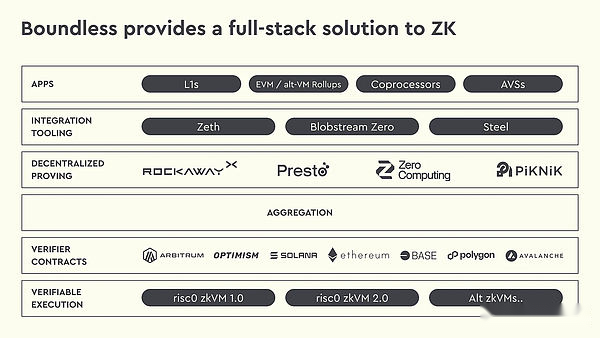
Blobstream Zero: Cross-chain bridge for zkVMs that simplifies cross-chain data verification
Blobstream Zero is a zkVM-based cross-chain bridge launched by RISC Zero and Celestia, aiming to seamlessly connect Celestia’s data availability layer to the existing modular blockchain ecosystem.By sharing and verifying data on Celestia, Blobstream Zero enables easier data transmission and verification between chains.
As a fully open source public product, Blobstream Zero allows any project or developer to run local instances and generate zero-knowledge proofs.In addition, Blobstream Zero is able to provide support for ZK coprocessors.The ZK coprocessor is essentially an off-chain computing tool, so it requires reliable data to perform the calculations.Blobstream Zero can obtain data from blockchains such as Celestia, and can prove that the transmitted data is reliable by generating ZK proofs.
Steel: A new paradigm of smart contracts for off-chain execution and on-chain verification
Steel is an open source tool launched by RISC Zero, which uses zkVM technology to enable off-chain verifiable smart contract execution.Through Steel, developers can transfer EVM operations from the chain to the off-chain execution, while generating zero-knowledge proofs to ensure the authenticity and verifiability of the calculation results.
Traditional smart contracts require the complete execution of all logic on the chain, which is not only expensive to Gas, but also limits the development of complex applications.Steel’s off-chain computing and on-chain verification mechanisms solve this problem.For example, in a simple smart contract, determine whether the ERC20 balance of an account is greater than 1 and increment the counter variable.Traditional methods require complete execution of logic on the chain, while Steel completes calculations off-chain and generates zero-knowledge proofs. Only proofs are required on the chain, without repeated execution of contract logic.
Currently, RISC Zero has released Steel 1.0, and partners have already used this tool to develop applications.For example, in a contract call that handles about 400,000 SLOAD operations, the calculation is transferred to off-chain execution via Steel, and the generated zero-knowledge proof is subsequently verified on-chain.Proof generation costs are less than $10, and on-chain verification costs are less than 300,000 Gas.
Kailua: A hybrid ZK solution that drives Rollup architecture innovation
Following the release of Zeth, RISC Zero has launched Kailua, aiming to provide an upgrade solution for optimism Rollup to a hybrid ZK Rollup.Traditional optimistic Rollup usually takes a 7-day challenge period, resulting in slower endurance in transactions, while ZK Rollup can achieve endurance quickly, the cost of continuously generating zero-knowledge proofs is too high.Kailua combines the advantages of both to achieve a balance between cost and efficiency through a hybrid architecture.As an extension of the Optimism Kona framework, Kailua not only supports unmodified Kona to run on zkVM, but also introduces innovative dispute resolution mechanisms that reduce staking requirements and end-of-sight delays, thereby improving system efficiency and availability.
In Kailua’s architecture, the dispute mechanism adopts a completely new design.First, its dispute resolution mechanism eliminates the time limit, allowing verifiers to have sufficient time to generate proofs when encountering special situations such as network interruptions, thereby enhancing the flexibility of the system.Even in extreme cases, the extension architecture of RISC Zero zkVM can be proven within one hour.In addition, Kailua’s on-demand verification feature allows developers to flexibly configure verification frequency to gradually transition to fully validated Rollup mode at a lower cost.
Unlike ZK Rollup, Kailua’s design does not require continuous proof generation.For low-frequency empty blocks or Rollup with special contract requirements, Kailua offers a more cost-effective option.At the same time, Kailua also significantly reduces the staking cost requirements of Rollup.The traditional optimistic Rollup’s pledge volume will increase linearly with longer end-of-life cycles, while Kailua’s optimized design fixes the pledge requirements, so that the system can maintain security and activity at a lower cost even over a long period of time.
Currently, Kailua is fully open source.Developers can use their command-line tools to deploy local Optimism test networks and quickly upgrade to a network that supports ZK proof of failure.Kailua also supports simulated failure proposals to help developers understand how validators challenge error status through zkVM to gain insight into its dispute resolution mechanism.In the future, Kailua will further optimize costs and performance and expand to more Rollup framework support.
Summarize
As can be seen from the above, RISC Zero’s zkVM product matrix is driving the development of zero-knowledge proof technology in multiple fields.Zeth and Kailua focus on Rollup architecture optimization, improving block verification efficiency and dispute resolution speed.Bonsai provides remote proof services, reducing hardware dependency and operation costs, and enabling developers to build applications more efficiently.Blobstream Zero provides reliable support for the modular blockchain ecosystem by efficiently verifying cross-chain data.In addition, Steel reduces the Gas cost of smart contract execution through off-chain computing and on-chain verification.
Of course, while continuously improving the zkVM product matrix, RISC Zero is also continuing to promote innovation in the underlying technology of zkVM.Recently, RISC Zero zkVM released version 1.2, introducing a new precompilation method that allows developers to deploy precompiled logic with applications without having to be built into zkVM itself.This means developers can add new precompiled logic without modifying the on-chain verification contract or coordinating the proofreader configuration, or forking or major changes to zkVM for performance optimization.In addition, by applying the definition precompilation, the computational cost of proof generation can also be reduced.For example, after Automata integrated RSA is precompiled, the execution cycle is reduced from 39 million to 217,000, which is about 180 times lowered the cost.
With the continuous optimization of zkVM technology, its development potential will be gradually reflected in multiple application scenarios. However, if these potentials are to be better released, it still depends on the actual performance of ecological collaboration and technology implementation.

